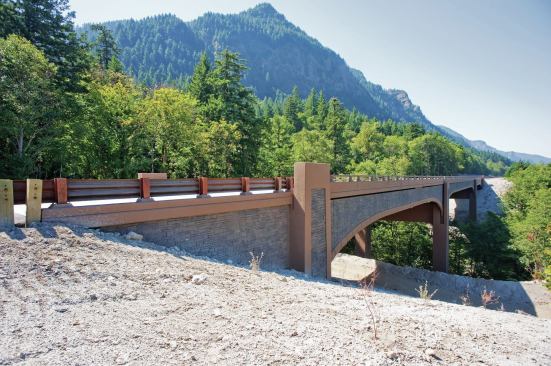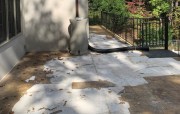Oregnd Department of Transportation
Newly constructed bridges in Oregon’s Columbia River Gorge are…
Connecting with downtown
With more than 20 galleries, four local theaters, and the internationally famous Oregon Shakespeare Festival, Ashland is a popular cultural destination that attracts art and theater buffs.
The bridge program repaired two bridges on Interstate 5 in Ashland—the first major bridges that travelers encounter on their journey north through Oregon on I-5. The project team wanted them to stand out, and looked for ways the bridges could reflect the city’s artistic vibe.
ODOT hired John Galbraith, founder of Galbraith and Associates, a local landscape architecture firm, and worked with the City of Ashland to recruit and organize an Aesthetics Advisory Committee made up of representatives from local businesses, committees, and city government commissions. Based on their recommendations, Galbraith and his team developed a series of preliminary renderings, and later revised them according to community feedback.
The bridges’ pylons, railings, and deck façades feature decorative shield-shaped emblems made of concrete. The design of these escutcheons mimics the art-deco style of the parapet on the Ashland Springs Hotel, a downtown landmark listed on the National Register of Historic Places. Created from head forms, the decorative features mounted on top of the supporting deck were cast separately and pinned in place after the concrete cured. The emblems were then stained the color palomino at the same time as the rest of the bridge.
Farther north on I-5, two more replacement bridges were needed near Canyonville, where the Cow Creek Band of Umpqua Tribe of Indians owns the Seven Feathers Casino. Hunting, fishing, and logging have been significant components of the local economy, and deer trophies and carved bears figure prominently in the décor of the casino and of the Canyon Market and Pioneer Park downtown. On these bridges, Victory Builders of Roseburg, specialists in carved concrete, created plaques of eagles, bears, and beavers, as well as a bridge facing that resembles a log, all of which won the approval of residents and tribal members. The plaques were created by placing unset concrete grout into hand-shaped wire mesh.
Protecting neighborhoods
Still farther north on I-5 in Eugene and Springfield, ODOT replaced the northbound and southbound interstate bridges over the Willamette River, each of which is almost 2,000 feet long and whose approaches pass by several neighborhoods.
To reduce the noise from projected increases in traffic on I-5, budget was allocated for two sound walls for two adjacent neighborhoods. Soundwall construction consisted of colored and acid-etched, rough-hewn concrete masonry units (CMUs). On the highway side, motorists see a rolling, pixilated representation of a sound wave, constructed from different colored split-face CMUs, which are an ODOT standard and match other soundwalls in the area. The contrasting shades of the CMU pattern carries through to the neighborhood side, which also features intermittent sculpted concrete forms representing local geology.
Installing soundwalls was one of several above-and-beyond creative responses to community concerns that helped ODOT build its relationships with citizens affected by construction during this prominent four-year project.
Engaging the entire community
Concrete artworks were the occasion for ongoing community cohesiveness when ODOT replaced five bridges on a short stretch of Oregon Route 38 near Elkton, whose population hovers around 150.
During a high school assembly that also served as an open house, Larry Gescher, project manager with prime contractor Slayden Construction Co. of Stayton, Ore., offered $500 to the student who came up with the best design for four decorative pylons to be installed on the main bridge over the Elkton River.
Working out a theme for the design became a collaborative community effort. Students interviewed family members and long-time citizens about what symbols they thought belonged in the design, and local artists were invited to the school assembly during which the project was discussed.
The students decided that the theme for the pylons should be Elkton’s past, present, and future. The winning design uses a Douglas fir log, representative of the local timber industry, as the base. To signify Oregon, the Beaver State, the top of the pylons imitate beaver-chewed logs, pointed, with a texture made up of rough teeth marks and scratches. A grapevine entwining the log symbolizes agriculture and tourism; carvings of four wildlife species significant to the area—steelhead, elk, osprey, and the Monarch butterfly—adorn the pylons.
Victory Builders again supplied carved concrete services, and the community gathered for an unveiling event to watch owner Pete Pappas and his team finish carving the final pylon out of shotcrete. The 10-foot pylons stand at the four corners of the Elk Creek Bridge, the main route in and out of Elkton.
Jim Cox is preservation and operations program manager in the Oregon Department of Transportation’s Technical Services Branch. He can be reached at 503-986-6612; e-mail jim.b.cox@odot.state.or.us.









